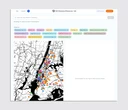In the late 2010s, at the height of the direct-to-consumer boom, Framebridge founder Susan Tynan was green with envy. Many other venture-backed startups from the era—like Casper, Away, and Glossier—were growing much faster than her custom framing business.
While these other buzzy brands focused on acquiring customers and growing revenue, Tynan was using her $81 million in venture funding to tackle more arduous operational issues, like building factories and hiring hundreds of craftspeople to make frames by hand.
Eleven years into the business, Tynan’s slow, steady approach to growth is paying off. Framebridge now has 750 employees, 500 of whom work at the company’s four factories in Kentucky, Virginia, and Nevada. Meanwhile, its brick-and-mortar footprint is growing rapidly, with 10 new stores opening last year (it now operates 40 physical stores) and more planned.
Tynan says that by investing in Framebridge’s infrastructure early on, she built a moat around the business that has allowed it to ward off competitors. And now the company is in a position to scale rapidly, actively looking to expand its network of brick-and-mortar locations, possibly into the hundreds.
Meanwhile, many DTC startups that Tynan once envied are fending off challengers that have created similar products, from mattresses-in-a-box to design-forward luggage. “Framebridge was a hard business to build, but that’s why it’s impossible to replicate,” says Tynan. “We’re now reaping the benefits.”
The DTC Boom and Bust
Today you’ll find a custom framing shop in most towns: By one estimate, there are more than 15,000 in the United States. But custom framing is notoriously expensive and takes a long time, which turns off many consumers who are happy to settle for a cheaper prefabricated frame they can buy from Michaels or Amazon.
As Tynan studied the framing business model, she found the industry laden with inefficiencies. Most frame shops are owned by a single person. Since the store can’t afford to keep hundreds of mats and frame options in stock, it will order the components only once the customer has made their selection. Buying in such small quantities is expensive; it’s also time-consuming to send out for these pieces and construct the frame in-store. Tynan, who started her career as a tech executive, decided to launch Framebridge because she believed she could make framing cheaper, faster, and more convenient.
Like many other VC-backed DTC startups, Framebridge was meant to disrupt a dusty industry. But Tynan’s business model was far more complex than those of peer brands of the 2010s. Startups like Casper and Away, which redesigned common consumer products, worked with overseas factories to make them, then sold the products online.
Framebridge, by comparison, needed to build out a complex logistical operation to create custom frames at scale. This would involve setting up factories in the States and hiring artisans to build custom frames. In 2020, Graham Holdings Co. (GHC) acquired Framebridge for an undisclosed amount, giving Framebridge’s investors a payout. The sale meant that Framebridge had a deep-pocketed holding company that would allow Tynan to keep investing in factories and other infrastructure at a time when many other DTC operations were seeking out ever-larger sums of VC capital or exploring an IPO.
Taryn Jones Laeben, who served as the chief commercial officer of Casper until 2018 before founding the VC firm IRL Ventures, believes Framebridge owes its success largely to one unique factor. “What makes Framebridge special is its supply chain,” she says. “Businesses that survived the DTC era are the ones that are truly differentiated. But investing in factories is complex because it is capital intensive and prevents you from being nimble. For Framebridge, it has clearly paid off.”
While GHC, which generated $4.7 billion last year, does not break out revenue for individual companies, its annual report noted that “Framebridge posted real growth in 2024.” That said, the report described Framebridge as an “investment stage business” that is not profitable yet.
The upshot is that it’s much harder to copy Framebridge’s business. Over the past five years, many DTC brands have struggled to acquire new customers, partly because a wave of competitors have popped up. Away is now competing with Monos, July, and Antler. The beauty and mattress industries have hundreds of direct-to-consumer players. To gain market share under these conditions, brands must continue pumping money into marketing and advertising. But no other companies have yet been able to replicate what Framebridge is doing.
The Moat
In 2014, the Framebridge website went live. It allowed customers to send in art or upload digital photographs to be framed and delivered back to them.
It seemed like a simple service. But Tynan had spent the previous two years—and $3 million in seed funding—to build out a factory in Richmond, Virginia. She hired a team of expert framers as well as some people from other creative professions who enjoy the work of framing. “I found someone who sold mantles on Etsy,” she recalls. “He loves using his hands.”
Framebridge orders large volumes of framing materials, which allows the company to charge less per frame than the average neighborhood framer. Small frames start at $50; larger pieces, like an 18-by-24-inch frame, cost $155. (This is roughly half of what my local frame shop in Boston charges.)
Framebridge’s concept resonated with customers, especially digital-native millennials who were already ordering everything from mattresses to house plants on the internet. Within three years of launch, the company had generated $58 million in revenue.
Laeben, the VC investor, says Tynan was smart about how her startup used its $81 million in VC capital. While many brands of the era were investing in customer acquisition, Framebridge was focused on infrastructure that would give it longevity. “They spent their money on durable, defensible strategies as opposed to acquiring customers on social media who might not even purchase from the company again,” she says. “Looking back, customer acquisition was basically like lighting money on fire.”
Many investors would not have been satisfied with Framebridge’s pace of growth, Laeben points out. “DTC is a very broad category. There are many sectors where it makes sense to grow slowly and profitably, but this means being aligned with your investors on what your goals are,” she explains.
As Framebridge grew, Tynan recognized the many benefits of having physical stores. While it’s possible to visualize frames on the company’s website, some customers simply want to see what the materials look like in person. More crucially, there are people who want to do business at a physical location where they can bring their expensive art and irreplaceable, precious keepsakes in person, rather than sending them through the mail, where they could be damaged or lost. So in 2019 Framebridge opened its first two stores in the Washington, D.C., area, and quickly began opening others in major cities such as New York and Boston.
Tynan also decided to buy a fleet of trucks to transport people’s items from the stores to the factory in Virginia. This is another complex, expensive part of the business—but one that Tynan believes strengthen’s her company’s “moat,” making it even less likely that a competitor will spring up. “If [customers] were going to send in their baby blanket or an antique family photograph, they needed to know it wouldn’t get lost,” Tynan says. “It was important to customers that their things remained in our chain of custody throughout the whole process.”
The Framebridge store footprint is much smaller than a traditional frame shop, since no actual framing happens on-site. The stores sometimes serve simply as a way to introduce people to the brand. Framebridge often hosts in-store events, offering free portrait sessions or photos with Santa during the holidays.
While some DTC brands saw retail stores primarily as a marketing engine, Tynan thought it was crucial that Framebridge learn how to run these stores profitably. “This wasn’t a pop-up strategy,” she says. “As a startup, you want to test a lot of things, but if you test them halfway, you don’t know if they’re actually going to work. So we put our best foot forward with these stores.”
The Future of Framing
Today, Framebridge still doesn’t have a major competitor that does what it can do. Instead, its biggest source of competition is the traditional, neighborhood frame shop. But Tynan says her goal isn’t to put these places out of business.
She points out that Framebridge has a particularly modern, millennial-oriented aesthetic that isn’t necessarily for everyone. And store associates are trained to point customers to other framing shops nearby if Framebridge doesn’t have what they’re looking for. “We have a curated assortment of frames,” Tynan says. “We have a point of view.”
Still, she believes there’s a lot of room to grow. Given how expensive custom framing has been in the past, few consumers create bespoke frames for their art. Most just buy premade frames. By offering less-expensive options and offering customers the ability to make selections online, Tynan hopes that Framebridge will appeal to people who might never have thought to custom frame their keepsakes or art before. “In many ways,” she says, “we’re only just starting to scale.”










No comments